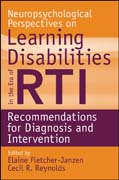
Neuropsychological perspectives on learning disabilities in the era of RTI: recommendations for diagnosis and intervention
Fletcher-Janzen, Elaine
Reynolds, Cecil R.
Neuropsychological Perspectives on Learning Disabilities in the Era of RTI isthe first text of its kind to present the latest research on neuroscience as it relates to informing new models developed for the Response to Intervention (RTI) framework for children with learning disabilities. Edited by recognized leaders in the field of neuropsychology and school psychology, this book contains well-researched, cutting-edge perspectives from experts in this field. INDICE: Chapter 1. Neuropsychology and Specific Learning Disabilities: Lessons from the Past as a Guide to Present Controversies and Future Clinical Practice (By Alan S. Kaufman). Chapter 2. RTI, Neuroscience, and Sense: Chaos in the Diagnosis and Treatment of Learning Disabilities (By Cecil R. Reynolds). Chapter 3. Neuroscience and RTI: A Complementary Role (By H. Lee Swanson). Chapter 4. The Education Empire Strikes Back: Will RTI Displace Neuropsychology and Neuroscience from the Realm of Learning Disabilities (By Merrill Hiscock andMarcel Kinsbourne)? Chapter 5. Nature-Nurture Perspectives in Diagnosing and Treating Learning Disabilities: Response to Questions Begging Answers That Seethe Forest and the Trees (By Virginia W. Berninger and James A. Holdnack). Chapter 6. Compatibility of Neuropsychology and RTI in the Diagnosis and Assessment of Learning Disabilities (By Cynthia A. Riccio). Chapter 7. Assessment versus Testing and its Importance in Learning Disability Diagnosis (By Julie A. Suhr). Chapter 8. Comprehensive Assessment Must Play a Role in RTI (By Steven J. Hughes). Chapter 9. The Need to Integrate Cognitive Neuroscience and Neuropsychology into a RTI Model (By Daniel C. Miller). Chapter 10. Neuropsychological Assessment and RTI in the Assessment of Learning Disabilities: Are They Mutually Exclusive (By David Breiger and Lawrence V. Majovski)? Chapter 11. Learning Disabilities: Complementary Views from Neuroscience, Neuropsychology, and Public Health (By Ronald T. Brown, Brian P. Daly, and Gerry A. Stefanatos). Chapter 12. Integrating Science and Practice in Education (By Richard Boada, Margaret Riddle, and Bruce F. Pennington). Chapter 13. Perspectives on RTI from Neuropsychology (By Scott L. Decker, Jessica A. Carboni, and Kimberly B. Oliver). Chapter 14. Neuropsychological Aspects of Learning Disabilities Determination: Scientific and Cultural Considerations (By Sangeeta Dey). Chapter 15. Identifying a Learning Disability: Not Just Product, but Process (By Colin D. Elliott). Chapter 16. Integrating RTI with Cognitive Neuroscience in the Assessmentof Learning Disabilities (By Steven G. Feifer). Chapter 17. Neuropsychology and the Implications for Policy, Diagnosis, and RTI By Lisa A. Pass and RaymondS. Dean). Chapter 18. Neuroscience, Neuropsychology, and Education: Learning to Work and Play Well with Each Other (By Michael D. Franzen). Chapter 19. Diagnosing Learning Disabilities in Non-Majority Groups: The Challenges and Problems of Applying Non-Neuropsychological Approaches (By Javier Gontier and Antonio E. Puente). Chapter 20. The Role of Neuroscience and Neuropsychology in theDiagnosis of Learning Differences and the RTI Paradigm (By Sally L. Kemp and Marit Korkman). Chapter 21. Q We Must Do (By Elaine Fletcher-Janzen).
- ISBN: 978-0-470-22527-1
- Editorial: John Wiley & Sons
- Encuadernacion: Rústica
- Páginas: 352
- Fecha Publicación: 20/02/2008
- Nº Volúmenes: 1
- Idioma: Inglés
